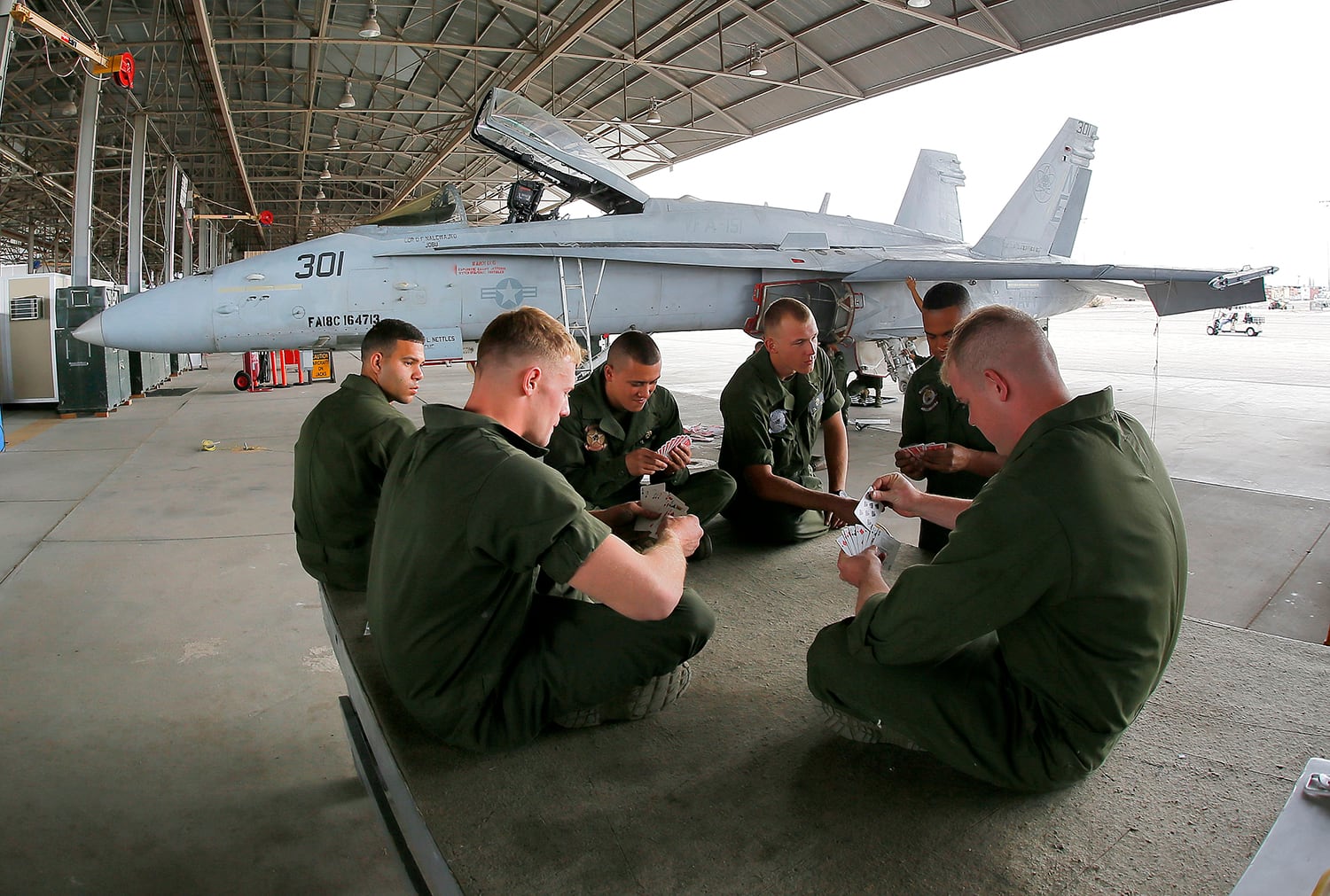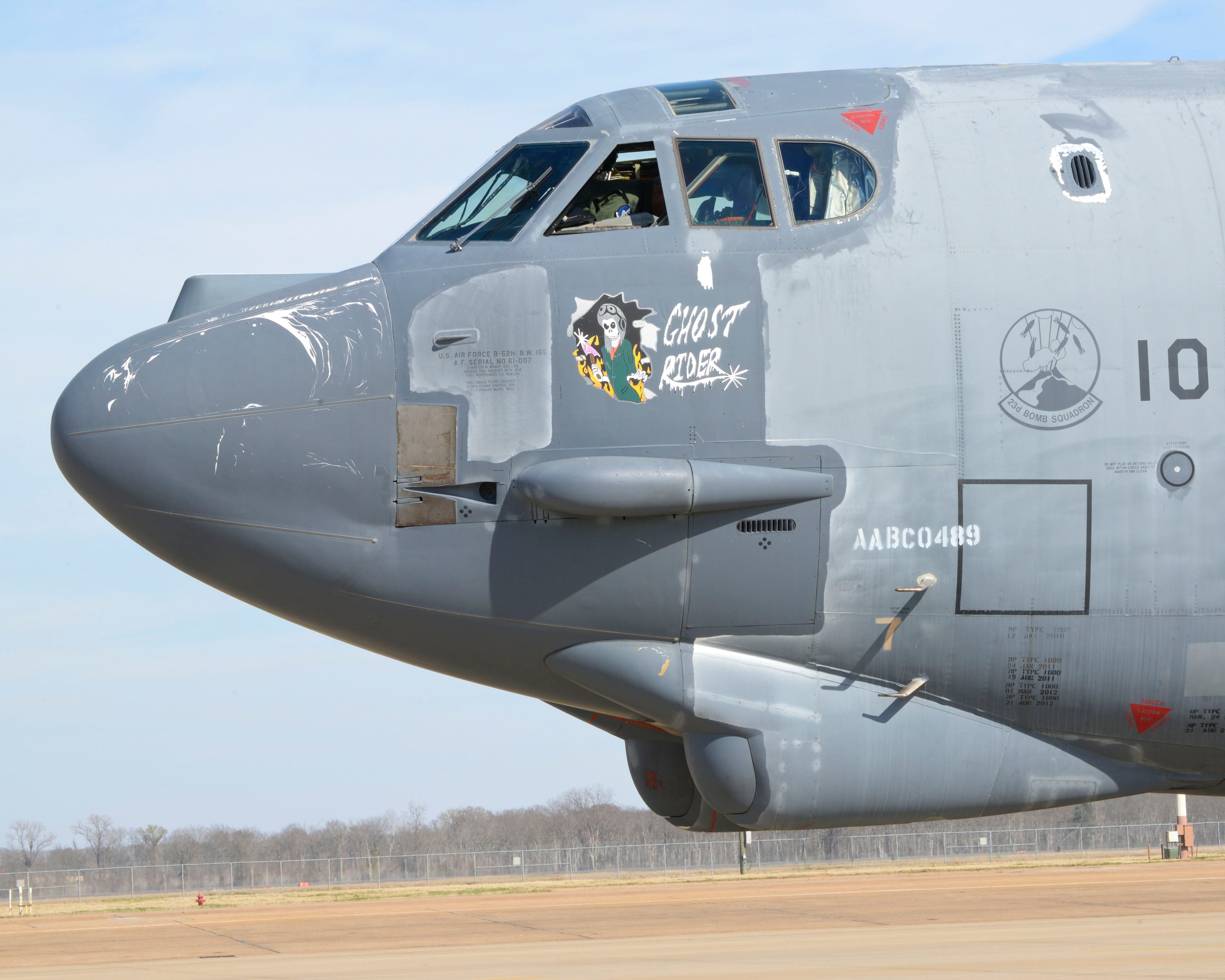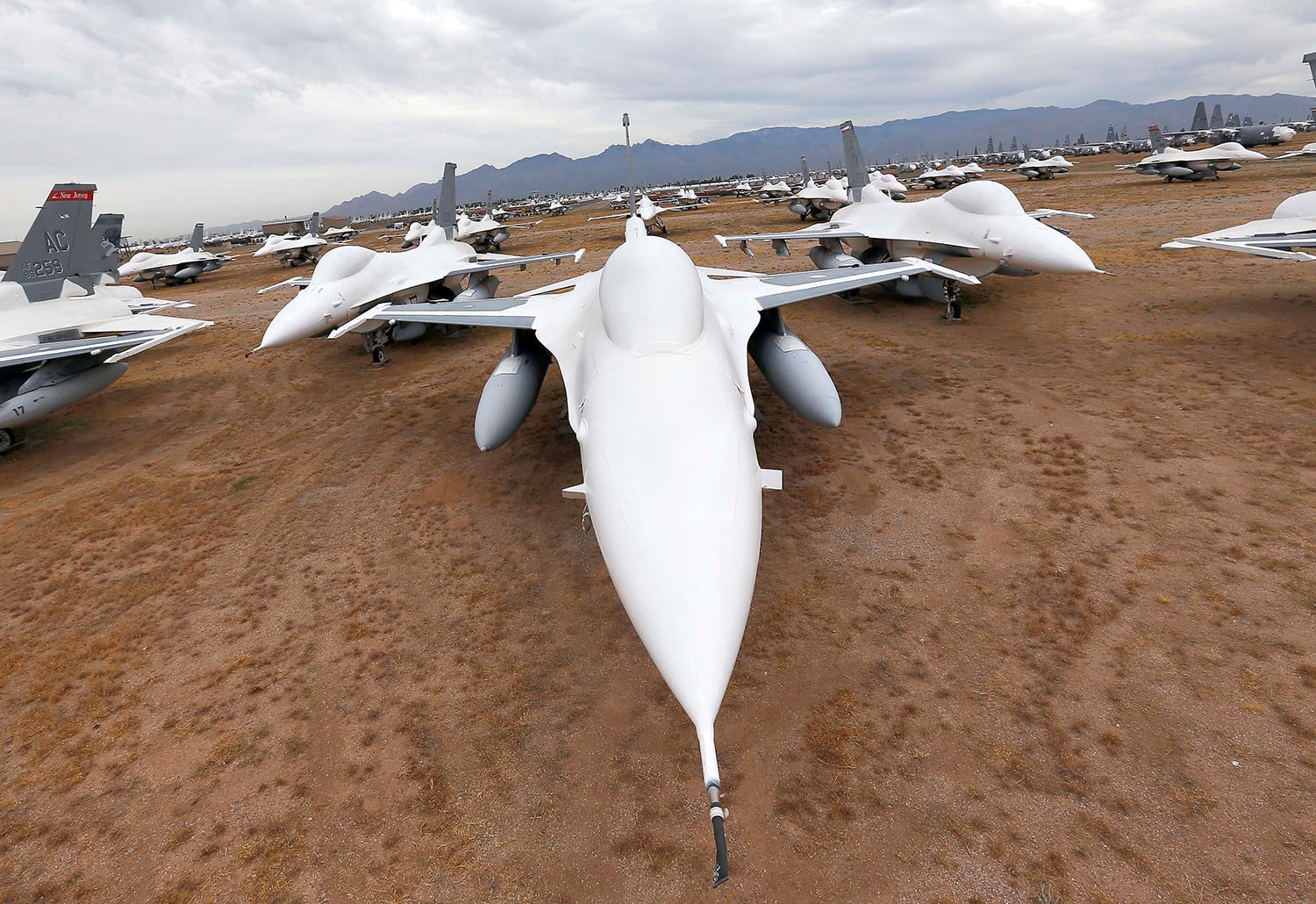TUCSON, Ariz. — As boneyards go, this place is pretty lively.
Before many Tucsonans have even started their morning commute, a pair of aircraft mechanics are already crouched over the open cockpit of an F-18 fighter jet, disarming the ejector seat and removing the explosives.
Nearby, a towing crew pulls a Navy P-3 anti-submarine aircraft over to the “flush farm” to be drained of its fuel. Then they hook up to a different F-18 and haul it to the “wash rack” for perhaps the last thorough cleaning it will ever get.
Meanwhile, about a mile away, a small army of specialty painters fans out to spray protective coating on row after row of mothballed C-130 transport planes.
Welcome to a typical morning at the 309th Aerospace Maintenance and Regeneration Group, Tucson’s most famous parking lot with roughly $34 billion worth of military might.
The people who work here generally refer to the place by its acronym, or “A-marg” as they call it. Most everyone else — here and around the globe — knows it as the airplane graveyard, or simply the boneyard.
But that nickname only tells part of the story.
Though the boneyard at Davis-Monthan Air Force Base is the final destination for most of the warplanes that end up there, some do return to the sky.
In May, AMARG restored a B-52 bomber to active duty after more than a decade in storage. Now workers at the facility are preparing dozens of retired F-16 fighter jets to fly again, this time as full-sized, “drone” aerial targets piloted by remote control.
They also help get surplus military machines ready for delivery to U.S. allies, like the six helicopters sent to Greece earlier this year and five more to be sold to Israel.
“Any day that you come here, there’s a really wide variety of things we could be working on,” says Air Force Col. Jennifer Barnard, now in her third year as group commander.

Arguably the boneyard’s most important mission is to serve as a giant, open-air parts warehouse for the U.S. military and others.
During the past fiscal year alone, AMARG “reclaimed” 5,744 different parts from the aircraft in its collection, saving taxpayers an estimated $405.9 million in replacement costs.
And as the only facility of its kind in the nation, the boneyard is often the only place to find the parts needed for certain types of older aircraft.
Barnard says simple, high-priority orders can be filled the same day, but larger, hard-to-reach parts can take weeks or months to harvest and deliver.
“We’ve done special cuts on aircraft, where we’ll cut a piece of an airplane and send it to somebody who needs it,” she says.
One of the C-130s that services the science stations in Antarctica sports a tail section that once soaked up the sun in Tucson.
“That’s kind of why we get looked at as an air power reservoir,” Barnard says. “Our guys take a lot of pride in preserving these aircraft and taking really good care of them. They know they might be needed again, whether it’s a whole airplane or just its parts.”
RELATED

Roughly 95 percent of aircraft arrive at the boneyard under their own power. They land and taxi through a gate at the southeastern end of the runway to be prepped for slumber.
Their first stop is the “flush farm,” where defueling supervisor Dale Pace and his crew can service up to six aircraft a day, depending on the type.
Pace says the task takes longer for large airplanes with multiple engines like the massive C-5 Galaxy transport. “That takes us forever and a day to defuel,” the former Air Force mechanic says.
It works a little like a blood transfusion. All of the aviation fuel is pumped out and replaced with a special oil, similar to the stuff used in sewing machines, that coats the tanks and fuel systems to protect them from corrosion. The only way to do that is by firing up the engines.
On this recent Thursday, the crew is working on the Navy P-3, which arrived at AMARG the week before and was towed to the flush farm earlier in the morning.
Two members of Pace’s team climb behind the controls of the retro-looking airplane and spin up all four props to burn off the last of the jet fuel and draw the oil into all the places that need protecting.
Pace stands outside the aircraft, watching the engines for the telltale sign that the exchange is complete. As soon as he sees puffs of white smoke, like at the Vatican, he motions to the men in the cockpit to cut the power.
To coat all the necessary engine parts in an F-15 or an F-18, the fighter jets have to be lashed to the ground and run with their afterburners on, creating a rumbling sound that echoes across Tucson.
The next stop is the wash rack, where men in protective rain gear give a Coast Guard C-130 transport plane a nose-to-tail scrubbing before it flies off to be outfitted to fight wildfires. The aircraft has already been painted with the U.S. Forest Service name and logo.
Nearby, other members of the six-man crew use high-pressure sprayers and industrial degreaser to clean A-10 wings and landing gear pods recently “brought in from the desert.”
The parts will be refurbished in a shop at AMARG and used to extend the life of the Air Force’s fleet of ground-attack jets, a mainstay at Davis-Monthan and in the skies above Tucson.
Wash rack supervisor Mike Sherry says that on average his crew cleans about four airplanes and 50 refurbished parts each week.
The men bake all summer in their rubber suits, then spend the cold winter outside soaking wet.
“It’s miserable work,” Sherry says. “It’s one of the hardest jobs at AMARG.”
It's also an important one. Cleaning the aircraft and their components makes them more resistant to decay, Sherry says.

The boneyard was established in 1946 to store World War II bombers and transports.
Tucson was chosen for its dry desert air — perfect for preventing corrosion — and hard caliche soil capable of supporting heavy airplanes without the need for thousands of acres of concrete.
It became the nation’s primary storage center for military aircraft in 1964, when about a thousand Navy planes were transferred to the site from a depot near Phoenix.
The facility’s inventory hit an all-time high of 6,080 aircraft in 1973, as the Vietnam War was winding down.
Today, AMARG is home to about 3,280 aircraft of 80 different varieties, from small helicopters to some of the world’s largest military cargo planes.
As Pace, the flush farm supervisor, puts it, “Everything for everyone ends up out here.”
Each branch of the military is represented, as are the Coast Guard, Border Patrol, FBI, Forest Service, NASA, the National Science Foundation and several allied governments.
The atmosphere at AMARG is businesslike but decidedly unstarched. Roughly 700 people work at the boneyard, and almost none of them are required to salute anybody.
Barnard is one of only three active duty Air Force personnel assigned to the operation. The rest are civilian Defense Department employees and government contractors.
A lot of the employees have military backgrounds and many of them served as aircraft mechanics.
Before he ended up as AMARG’s wash rack supervisor, Sherry used to maintain fighter jets at Luke Air Force Base in Phoenix, among other places.
Some aircraft show up with personal notes written on them by the last people to fly them.
Sherry points to the F-18 that was just brought to his crew for a wash. There on the nose cone, a pilot with the call sign “Dude Bro” has left his goodbye in black Sharpie: “Thank you for your service ol’ girl.”
Sherry says AMARG occasionally invites pilots out to watch when one of their old airplanes is ready to be retired for good, once all the usable parts have been harvested and the thing is about to be cut up and crushed into little pieces.
“We try to find the pilots who had the last flight on them. To watch them get choked up, it’s heart-wrenching,” he says.
Dean Clark and Gary Chartier play a crucial role at the boneyard. They’re the ones who make sure no one gets blown up or launched into the sky while working on one of the mothballed warplanes.
Today they are disarming the ejection system on an F-18. Standing at the top of some rolling metal stairs, Clark reads the steps off a checklist as Chartier leans down into the cockpit to disconnect and remove the explosive charges.
Clark says the process usually takes three to four hours, depending on the age of the aircraft.
Older F-18s are the worst, he says. “There’s a bunch of springs and wires. It’s annoying.”
This is the last step in the “induction” process before an airplane gets towed out to what boneyard workers call “the desert,” though it isn’t a desert at all.
The storage area actually sits on roughly 2,600 acres of hard-packed dirt dotted with weeds, crabgrass and anthills. There, the airplanes are parked in neat rows and loosely grouped based on their status, which can range from ready to fly to soon to be scrapped.
Generally speaking, “anything that’s east of Kolb (Road), it will never fly again,” says Leo Bernier, a storage services work leader.
The far east end of the property is also where AMARG stores about 280,000 pieces of aircraft production tooling, just in case a defense contractor wants to fire up its factory again and start churning out new airplanes or parts.
Anything in the boneyard that still has wings — unless it’s an actual quail or owl — quickly gets lashed down with cables.
“Airplanes by nature like to fly, so when the wind blows you want them to stay on the ground,” Barnard says.
The final step in the storage process belongs to what everyone still calls the “Spraylat crew,” even though the boneyard doesn’t use that particular brand of spray-on latex coating anymore.
Using a “sealing diagram” supplied by the owner of the aircraft, the painting crew will cover every window, access panel, seam and opening with easy-to-peel paint and a reflective thermal coating to help keep the inside of the aircraft cool while protecting the machine from the elements.
The workers start the way any house painter might — by marking off parts of the aircraft with a special type of painter’s tape that pulls off easily without damaging the vehicle’s finish or leaving behind any sticky residue. Then they spray on two to three coats of black latex paint, followed by two coats of white vinyl similar to the flexible coating found on the flat roofs of many Tucson homes.
It’s “not really rocket science,” but it is exacting, says Bernier, who leads one of the painting crews. Each coat is measured down to the millimeter to make sure it is thick enough to do the job but can easily be peeled off later if necessary.
Coating a C-130 requires roughly 3,000 square feet of sealant that can take five to six days to apply. Your standard fighter jet usually takes four to five days. Certain helicopters have to be completely cocooned, which can eat up a full week.
The coating is designed to last five years, so Bernier and company have to reapply it to some of the aircraft that are stored for longer than that.
This is the most visible part of the operation, the part of AMARG the general public probably recognizes from looking at aerial photos or driving past the base.
To some people, all those idle but expensive airplanes represents an enormous waste — acres upon acres of needless military expenditures collecting dust in the desert sun.
But Bernier sees the boneyard like a bank account.
Every part of every aircraft they can save and pull back out later is one less part that needs to be bought or built somewhere else.
“We’re saving billions of taxpayers’ dollars,” Bernier says as he stands in the shadow of a C-130 in the middle of its paint job. “That’s what it comes down to.”
